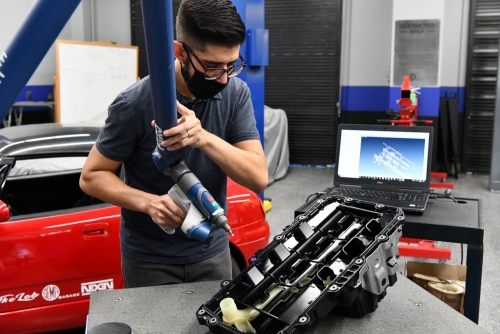SEMA News—December 2019
RETAILER BEST PRACTICES
Brand Selection:
Tapping the SEMA Data Co-op to Drive Retail Growth
 By working with a data repository such as the SEMA Data Co-op retailers of any size or type can easily hone a strong product mix that reflects their brand and customer base for increased growth. |
Basic to any retailing operation is identifying the right product mix to stock your store’s shelves or populate your website. Equally important is the ability to help consumers make sound purchasing decisions by supplying them with accurate, comprehensive information about those products. But with so many brands and application descriptions flooding the marketplace, where does a retailer begin?
With its free services to data receivers and a database of nearly 500 brands representing millions of part numbers, the SEMA Data Co-op (SDC) is an ideal tool to zero in on trusted brands and products for your customers and the comprehensive, accurate data needed to sell them.
Digital Drives Sales
Compelling reasons for resellers to tap into a robust database like the SDC include the fact that the “2019 SEMA Market Report” projected specialty-equipment sales to top $46 billion by 2020 in the U.S. market alone, with digital assets comprising a key driver.
“Consumers buy specialty-equipment products from a wide variety of retail locations,” the report noted. “The in-store experience continues to shine, as nearly 60% of all spending is done in brick-and-mortar channels, [but] digital channels are unquestionably important for both shopping and research.”
Today’s consumers are increasingly sophisticated with their online searches, checking everything from part numbers and fitments to price and even item availability. Satisfying their thirst for knowledge can give a retailer a leg up on the competition. Moreover, an online presence obviously widens a retailer’s geographical reach and opens up a 24/7 sales channel. So whether retailers are strictly brick and mortar, e-commerce or a combination of both, it behooves them to take advantage of the full range of digital assets available from parts suppliers.
“There are many types of resellers who join the SDC, and I wouldn’t say that there’s one type any more than another,” said SDC Director of Operations Gigi Ho. “We get a lot of solely e-commerce resellers, a lot of resellers who are actually buying parts online, installers and retailers who also have brick-and-mortar shops. You name it, there’s a pretty wide variety.”
According to SDC Customer Service Coordinator Sophia Cardona, the SDC offers a number of advantages to retailers, not the least of which is making sense of the marketplace.
“They’re coming to us for product information, and we have it on almost 500 brands,” she explained. “It’s mapped out very nicely for them in different types of formats. We’re talking about pricing, attribute information, ACES and PIES information—anything that you can think of that you would actually see on a website.
“We also offer a complimentary account if they sign up with the SDC, meaning they don’t pay, which is great, because most of our competitors do charge a fee. And another advantage to coming onboard with the SDC is the fact that our resellers get quick responses from our staff. That’s one of their biggest concerns. They don’t want to make a phone call or send an email and not hear anything back days or even a week later. The fact that they know they’re reaching real people who are responsive, who know the technology and care about them, makes a difference.”
Cardona further noted that the SDC is easily scalable for any size retail business, from mom-and-pop startups to larger, more established resellers looking to expand their offerings.
“We offer solutions for people at any stage,” she said. “Our data is helpful for those who are still in the development stages and not up and running yet, and our data is useful for those who may have had a website for a number of years.”
Once in the SDC system, retailers utilize online tools to quickly search and hone in on the suppliers and products that best meet their needs. They then send a request to the suppliers through the system for approval to begin receiving the datasets. Upon approval, the formats in which they receive that data are up to the retailer.
“If they’re used to looking at Excel files, they can receive it that way,” Ho explained. “If they want text, they can receive that. If they’re more sophisticated and want the direct-feed API or programmed-type feed, we can provide that, too. So really, we have a lot of technology services built in so that they can really get the information they want in the format that they need.
“And even in those exports, they can select certain product categories. So if they work with a carburetor supplier—even though that brand may manufacture many other products—they can select just to receive information on the carburetors, since they might get their injectors or their rockers from another source. They can be very specific as to their own experience and how they want to work with those different brands to suggest the products to
their customers.”
Data Best Practices
Once a retailer has joined the SDC, there are several best practices for utilizing the data they receive. First and foremost is the need to view product data as a communication stream from manufacturer to reseller to consumer. It’s like a business transaction in which all the industry parties must be mindful of how mishandled or poorly presented data can negatively impact everyone in the chain.
“It’s all about creating sales for both suppliers and resellers, so if the communication isn’t clear or the presentation of the data isn’t clear, it can cause issues,” Ho explained. “That’s why everyone is so careful about what they’re transmitting, what they’re receiving, and how it’s going to be communicated to the customer base.”
“One thing that I can specifically speak to is the sellers’ knowledge of data standards,” Cardona added. “They need to understand the differences between PIES and ACES and what they can expect when selling aftermarket products. They’re dealing with automotive aftermarket data and not just data that has to do with T-shirts or household items. Automotive aftermarket data is really complex, so they definitely want to be as knowledgeable as possible to help them sell those products. They should also train whoever is getting calls from their customers about the products.”
To help train new resellers in PIES, ACES and related aftermarket data standards, the SDC regularly directs them to the highly informative Autocare Association website (www.autocare.org). The SDC also has its own documentation useful to newer resellers as well as those desiring to further their expertise. In addition, Cardona conducts ongoing training for retailers through regular Go-To Meeting sessions. Those sessions cover everything they need to know to navigate the SDC system, request datasets, get exports and more.
“Another best practice in line with knowing the product data is actually knowing the products themselves,” Ho said. “It’s very tempting to think there are millions of products you could be selling, especially when you hear that the SDC has nearly 500 brands. That’s not a good strategy, because that level of product information requires a lot of upkeep. You want to have your pricing up-to-date, your digital assets up-to-date, and your descriptions tailored to your audience. Don’t drink from the fire hose; be very selective about the brands you’re requesting. You want to feel a comfort level with those brands because you are going to represent them. Your customers are going to look to you as a resource.”
| Executive Summary | |
Finding the right product mix to offer your customers is key to retailing. So is providing them with all the information required to make intelligent purchase decisions. The SEMA Data Co-op is an industry-owned product-data repository encompassing more than 500 brands.
|
Ho further advises e-commerce retailers to pay extra attention to hiring the right people to build and manage their websites.
“You should definitely have a web developer who’s also familiar with automotive product data,” she said. “Many developers think data is data. When they finally realize that certain products only fit certain vehicles, it just blows their minds.
“We like to use the analogy that when you go to the REI website for a sleeping bag, you’ll be asked about the length of the bag, the fill and maybe the color and style. But at no time does REI ask you the year, make and model of your tent. Nor does your tent explode if you buy the wrong bag. An aftermarket e-commerce site is not REI. There’s so much more involved with parts selection and fitment.”
Remember also that websites featuring “rich data” are a hit with consumers. Rich assets include not only ACES and PIES information but also short and long product descriptions, specs and “rich media” encompassing multiple images and videos. The SDC designates manufacturers that offer such comprehensive data as Platinum suppliers, and e-commerce sites will especially benefit from seeking them out and utilizing their full range of digital assets.
In the end, Cardona said, skillful data management is an exercise in branding.
“Certainly, we want to help retailers take more ownership of their brand, their store and their online presence,” she noted. “The aftermarket isn’t a set-it-and-forget-it industry or a quick-buck proposition. Success requires involvement.”
Learn More
For more information about SDC services and membership, visit www.semadatacoop.org or email Sophia Cardona at sophiac@semadatacoop.
org.






